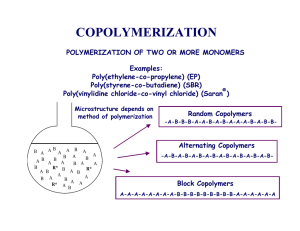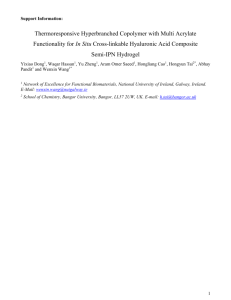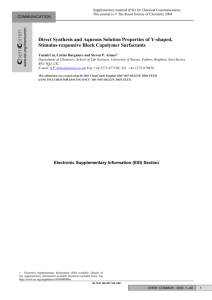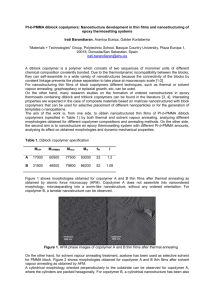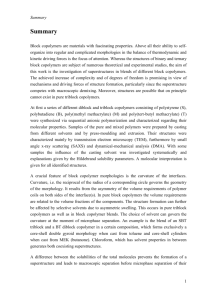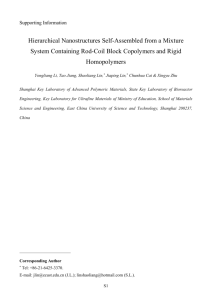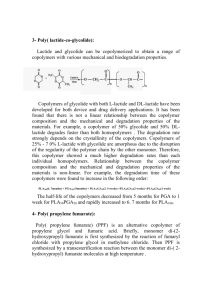In Situ Gelling Polyvalerolactone-Based Thermosensitive Hydrogel for Sustained Drug Delivery
advertisement
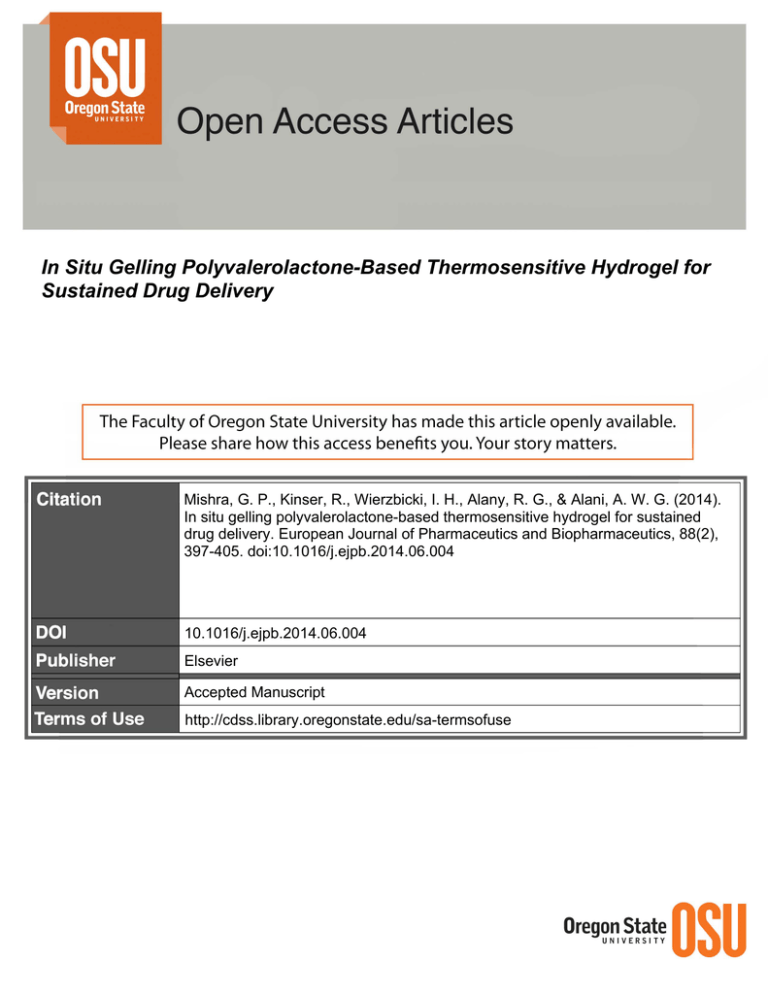
In Situ Gelling Polyvalerolactone-Based Thermosensitive Hydrogel for Sustained Drug Delivery Mishra, G. P., Kinser, R., Wierzbicki, I. H., Alany, R. G., & Alani, A. W. G. (2014). In situ gelling polyvalerolactone-based thermosensitive hydrogel for sustained drug delivery. European Journal of Pharmaceutics and Biopharmaceutics, 88(2), 397-405. doi:10.1016/j.ejpb.2014.06.004 10.1016/j.ejpb.2014.06.004 Elsevier Accepted Manuscript http://cdss.library.oregonstate.edu/sa-termsofuse In Situ Gelling Polyvalerolactone-Based Thermosensitive Hydrogel for Sustained Drug Delivery Gyan P. Mishra1, Reid Kinser1, Igor H. Wierzbicki,1 Raid G Alany,2,3 and Adam WG Alani1,* 1 Department of Pharmaceutical Sciences, College of Pharmacy, Oregon State University, Corvallis, OR, USA. 2 School of Pharmacy and Chemistry, Kingston University-London, The United Kingdom 3 School of Pharmacy, The University of Auckland, Auckland, New Zealand *Corresponding author: Adam Alani, Ph.D., Department of Pharmaceutical Sciences, College of Pharmacy, Oregon State University, Corvallis, OR 97331. Email: Adam.Alani@oregonstate.edu Tel: +1 541 737 3255 Fax: +1 541 737 3999 Abstract Biodegradable poly(ethyleneglycol)-poly(valerolactone)-poly(ethyleneglycol) [PEG-PVL-PEG] copolymers were synthesized through ring opening polymerization of δ-valerolactone (VL) followed by the coupling of monomethoxy poly(ethyleneglycol-poly(valerolactone) (mPEGPVL) with hexamethylene diisocyanate (HDI). The copolymers were characterized by 1H NMR, FT-IR, and GPC. Block copolymers of PEG and PVL with different VL/PEG molar ratios were successfully synthesized. One of the copolymers (Copolymer 2, PEG550-PVL6768-PEG550) displayed a sol-gel transition at a physiological temperature based on the test tube inverting method and rheological studies. The thermogelling copolymer demonstrated a characteristic crystalline peak for PVL block as determined by DSC and XRD analysis. In vitro release from the copolymer hydrogel matrix indicated that dexamethasone (DEX), a hydrophobic model drug, released comparatively slower than 5-fluoruracil (5-FU), a hydrophilic model drug, due to the potential partitioning of DEX into the PVL core. 5-FU in vitro release from copolymer 2 was 86% in 22 hr, whereas only 14% of DEX was released in 24 hr. Cell viability studies confirmed that hydrogels composed of block copolymers are biocompatible. Copolymer 2 showed more than 80% relative cell viability at all concentrations, including concentrations greater than 200 fold CMC. In vivo gel formation studies indicate that gel integrity was maintained for 7 days upon subcutaneous injection into mice. These results indicate that PEG-PVL-PEG copolymers are suitable for drug delivery applications. Keywords: δ –valerolactone; thermosensitive hydrogel; polyester; In situ gelling Abbreviations 1 H NMR 5-FU Proton nuclear magnetic resonance 5-fluoruracil CDCl3 CMC DEX DMEM DPH DSC FBS FT-IR GPC HDI LCST deuterated chloroform critical micelle concentration dexamethasone Dulbecco’s Modified Eagle medium dexamethasone and 1,6-diphenyl-1,3,5-hexatriene Differential scanning calorimetry Fetal Bovine Serum Fourier transform infrared spectroscopy Gel permeation chromatography hexamethylene diisocyanate lower critical solution temperature Mn mPEG-PVL Number Average Molecular Weight monomethoxy poly(ethyleneglycol-poly(valerolactone) Mw PCL PDI PEG PEG-PVL-PEG PLA PLGA PVL VL WAXD XRD Weight Average Molecular Weight polycaprolactone polydispersity index polyethyleneglycol poly(ethyleneglycol)-poly(valerolactone)-poly(ethyleneglycol) polylactide poly(lactic-co-glycolic acid) polyvalerolactone δ-valerolactone Wide-angle X-ray diffraction X-ray diffraction 1. Introduction The past decade has seen considerable interest in thermosensitive polymers as an emerging platform for drug delivery and tissue engineering applications [1]. For drug delivery applications this technology offers remarkable benefits due to the unique nature of these polymers which allows them to exist as solutions at room temperature and undergo a transformation into a gel at higher temperatures. The advantages of maintaining a drug delivery system for parenteral applications in the solution state are ease of manufacture, syringeability, sterilization through filtration, and in situ administration [1]. In addition, the ability to tailor these polymers to gel at physiological temperatures, and degrade at specified rates, while being biocompatible and biodegradable, tremendously increases the versatility of this platform to achieve sustained release, through parenteral delivery while minimizing patient discomfort and increasing patient compliance [2]. Polyester-based thermosensitive polymers have a superior advantage compared to other polymers, such as poloxamer 407, when used for thermosensitive gelling due to their ability to degrade in the biological milieu while most polymers are only biocompatible when used for these application [3, 4]. Temperature sensitive polyester block copolymers undergo sol-gel transition at a temperature known as lower critical solution temperature (LCST) [5]. The transition depends upon composition, molecular weight, and hydrophobic chain length as determined by structure property relationship studies [6]. The primary mechanism through which the copolymers exhibit sol-gel transition is micelle aggregation [7]. Thermogelling copolymers composed of polymers such as polylactide (PLA), polycaprolactone (PCL), and poly(lactic-co-glycolic acid) (PLGA) have been evaluated extensively [8-11]. Block copolymers of ABA or BAB type, where A and B represent hydrophobic and hydrophilic blocks respectively, have been reported to demonstrate temperature sensitive phase transition [3]. Triblock polymers of ABA type include PLGA–PEG–PLGA and PCL–PEG–PCL [12, 13] while examples of triblock polymers of BAB type are PEG-PLA-PEG and PEG-PCL-PEG [8, 14]. These polyester-based hydrogels have demonstrated high mechanical strength and long durations of maintaining gel integrity [15]. The polyester copolymers are safer for drug delivery as the final hydrolytic products are rapidly eliminated through the normal metabolic pathways [15]. Block copolymers composed of low molecular weight PEG and polyesters exhibit thermoresponsive behavior due to hydrophobic interaction between polymer chains [8]. Based on the hydrophobic domain the characteristics of the thermogel differ. For example PLGA and PLA-based thermosensitive hydrogels undergo faster degradation into acidic products in contrast, PEG-PCL diblock copolymers demonstrate extremely slow degradation (> 10 months) upon subcutaneous administration to rats [16]. In addition, thermosensitive hydrogels of PEGPCL-PEG and PCL-PEG-PCL tend to be unstable and gel at room temperature due to crystallization of PCL blocks, and this can affect syringeability [13, 17, 18]. Therefore, a need exists to develop polyester-based thermosensitive hydrogels with intermediate degradation characteristics with appropriate stability to expand the sustained release platform for small molecules and macromolecules. In this work, we have investigated polyvalerolactone (PVL) based block copolymers, for the development of a thermosensitive gel. Because PVL is synthesized from δ-valerolactone (VL), a six membered lactone ring, it is comparatively less hydrophobic than PCL. PVL-based hydrogels undergo a faster rate of breakdown due to aqueous hydrolysis and enzymatic degradation through lipases to generate lower molecular weight by-products that can be easily eliminated [19, 20]. To date there are no reports in the literature on PEG-PVL-PEG copolymer as a thermosensitive hydrogel. The objective of this study is to synthesize and characterize different compositions of PEG-PVL-PEG block copolymers and characterize these block copolymers in vitro in terms of their rheological behavior, biocompatibility in RAW 264.7 macrophages, and in vitro drug release profile for a model hydrophilic drug (fluorouracil, 5-FU) and a model hydrophobic drug (dexamethasone, DEX). In situ gelation and degradation of thermosensitive hydrogel were also evaluated in mice after subcutaneous injection. 2. Material and Methods 2.1. Materials Monomethoxy polyethylene glycol (mPEG) (Mw =550), δ-valerolactone, stannous octoate, 5fluoruracil, dexamethasone and 1,6-diphenyl-1,3,5-hexatriene (DPH) were received from SigmaAldrich, Inc. (Milwaukee, WI). RAW 264.7 (macrophage; Abelson murine leukemia virus transformed cells) was purchased from American Type Culture Collection (Manassas, VA). Cell culture supplies including Dulbecco’s Modified Eagle medium (DMEM), Fetal Bovine Serum (FBS), Trypsin EDTA, and Penicillin/Streptomycin were purchased from VWR (Radnor, PA). CellTiter-Blue® Cell Viability Assay kit was obtained from Promega, Inc. (Madison, WI). Hexamethylene diisocyanate (HDI) was obtained from Acros Organics-Thermo Fisher Scientific (Waltham, MA). Polystyrene GPC/SEC calibration kit was ordered from Agilent Technology (Santa Clara, CA). All other reagents were of analytical grade and purchased from VWR International, LLC (Radnor, PA) and Fisher Scientific, Inc. (Fairlawn, NJ). 2.2. Methods 2.2.1. Synthesis of poly(ethyleneglycol)-poly(valerolactone)-poly(ethyleneglycol) [PEGPVL-PEG] The triblock copolymers PEG-PVL-PEG were synthesized using ring opening polymerization at 130 °C (Fig. 1). mPEG 1 g (1.8 mmol) was added to a 100 mL round bottom Schlenk flask equipped with a flushing adapter, and dried at 130 °C under argon for 4 hr. Subsequently, VL at different molar ratios of 15 mmol (1.5 g), 25 mmol (2.5 g), or 35 mmol (3.5 g) was added and ring opening polymerization was carried out using mPEG as initiator and stannous octoate (0.05% w/w) as a catalyst. The reaction was carried out for 24 hr under argon atmosphere. The reaction mixture was dissolved in methylene chloride and precipitated with diethyl ether followed by vacuum drying at room temperature for 48 hr. The collected product (PEG-PVL) was coupled with HDI to yield the final products. Briefly, PEG-PVL (2 mmol) was reacted with HDI (1 mmol) at 60 °C for 6 hr under continuous stirring (Fig. 1). The resulting triblock copolymer was in methylene chloride and fractionally precipitated with diethyl ether. The final product was vacuum dried at room temperature for 48 hr. The collected final products were three triblock copolymers with different PVL/PEG molar ratios, designated as copolymer 1, copolymer 2, and copolymer 3. 2.2.2. Characterization of PEG-PVL-PEG copolymers Proton NMR spectroscopy (1H NMR) technique was utilized to elucidate the chemical composition of the synthesized triblock copolymers. Copolymer 1, copolymer 2, and copolymer 3 were dissolved in deuterated chloroform (CDCl3) and 1H NMR spectra were recorded using Bruker 700 MHz Avance III spectrometer (Bruker Biosciences Corporation; Billerica, MA). The Number Average Molecular Weight (Mn (NMR)) for each copolymer was calculated based on the number of repeating units for PEG and VL. Fourier transform infrared spectroscopy (FT-IR) was utilized to confirm the chemical structure of the synthesized triblock copolymer. For these measurements the triblock copolymer samples were dissolved in methylene chloride and casted on KBr plates. The FTIR spectrum was obtained at a resolution of 4 sec-1 with 16 scans using a Thermo Scientific NICOLET™ IR100 FT-IR Spectrometer (Thermo Fisher Scientific; Waltham, MA). Gel permeation chromatography (GPC) analysis was performed for each of the copolymers to evaluate the Weight Average Molecular Weight (Mw), Mn, and polydispersity index (PDI). The GPC measurements were performed using a Viscotek system equipped with Viscotek GPC Max VE 2001 solvent sample module, column oven 90-225 revH, Viscotek VE 3500 RI detector, and Viscotek 270 Dual Detectors (light scattering and viscometer detectors) (Malvern; UK). Waters Styragel HR columns 1 and 2 were used in tandem (Waters; Milford, MA) with Tetrahydrofuran (THF) as the eluting solvent with a flow rate of 1 mL/min. The columns were maintained at 40 °C for the duration of analysis. Copolymers were solubilized in THF at a concentration of 50 mg/mL and filtered through 0.2 micron filter. Mw and PDI were computed using a universal calibration curve plotted using narrow polystyrene standards. All measurements were performed in triplicate. 2.2.3. Determination of critical micelle concentration (CMC) of the copolymers The CMCs of copolymer 1, copolymer 2, or copolymer 3 were determined by DPH solubilization method [21]. Briefly, 50 µl of DPH solution (0.4 mM) in methanol was added to copolymer solutions in the concentration range of 0.004 to 0.06 wt%. The copolymer solutions were maintained at 25 oC for 12 hr to reach equilibrium. This was followed by fluorescence measurements at excitation and emission wavelengths of 358 and 430 nm, respectively using a Cary Eclipse Fluorescence Spectrophotometer (Agilent Technologies; Santa Clara, CA). The excitation and emission slit width were 2 and 10 nm, respectively. DPH fluorescence intensity was plotted as a function of copolymer concentration. The copolymer CMC value was determined at the point of intersection of the straight line drawn through the fluorescence intensity at the low copolymer concentrations and the straight line through the fluorescence values in the region of high intensity [21]. All measurements were performed in triplicate. 2.2.4. Sol–gel phase transition behavior The sol–gel transition and the thermoresponsive nature of the aqueous copolymeric solutions were serially investigated by the test tube inverting method followed by a rheological assessment using a rheometer. In the test tube inverting method, copolymers 1–3 were assessed in the concentration range of 15–30 wt% over a temperature range of 10–50 oC to determine the LCST for each concentration tested. The copolymer solutions were prepared in 10 mM phosphate buffer saline and 2 mL of each of the solutions was transferred into separate 3.7 mL tightly screw capped vials (inner diameter 13 mm). Then the vials were slowly heated in a water bath from 10– 50 oC at a rate of 1 °C/min The LCST was determined by inverting the vial for 30 s and evaluated for flow. The temperature at which no flow occurred in the above conditions was determined to be the LCST for that concentration of the copolymer. The concentration range investigated was based on previously published data [8, 13, 18, 22], which indicates that polyester copolymers tend to exhibit sol-gel behavior at 20–25 wt% concentrations. In addition, above 30 wt% concentration the copolymer solutions exhibited high viscosity, limiting the syringeability of these solutions, and therefore preventing the pursuit of further studies. The copolymer(s) and the respective concentration(s) that exhibited sol-gel behavior at physiological temperature (37 oC) were identified, and this group was further investigated rheologically using an AR 2000ex rheometer (TA Instruments; New Castle, DE). For this set of experiments, the concentration(s) of the copolymer(s) that exhibited LCST at 37 oC were placed between a 25 mm parallel plate and the gap was adjusted to 1 mm. Temperature dependent changes in viscosity were measured at a controlled shear rate of 0.1 s-1 and a heating rate of 1 °C/min in the temperature range of 10–50 °C. 2.2.5. Differential scanning calorimetry (DSC) DSC measurements were performed using a DSC Q200 (TA instruments Inc; Newcastle, DE) instrument. The thermal properties of copolymers were determined by heating the copolymer to 60 °C followed by cooling to 10 °C at a rate of 10 °C/ min. After cooling, a second heating was performed at 10 °C/ min and the DSC spectrum was recorded. 2.2.6. Wide-angle X-ray diffraction (WAXD) WAXD was performed using a Bruker-AXS D8 X-ray powder diffractometer (Bruker Biosciences Corporation; Billerica, MA) with a Cu-kα radiation source (45kV and 15 mA). The measurements were made at room temperature by scanning samples in the 2–theta range of 1060° at a scan rate of 5°/min. 2.2.7. In vitro release studies 5-FU or DEX as hydrophilic and hydrophobic model drugs respectively were loaded into the hydrogel matrix by simple mixing method. Briefly, 0.5 mL of the 1% drug in 25 wt% copolymer solution was added to a 10 mL tube of 10 mm diameter and the temperature was increased to 37 o C to form the gel. Ten minutes post gel formation, 5 mL of phosphate buffer (pH 7.4) pre- warmed to 37 °C was added at the top of gel matrix with the initial surface area of 2.0 cm2. The drug release experiments were performed at 37 °C in a shaker bath adjusted to 60 rpm. Samples of 4 mL were withdrawn for 5-FU at 0.5, 2, 4, 6, 23, 71, 110, 160, 220, and 300 hr and DEX at 0.5, 8, 12, 24, 48, 85, 110, 160, 220, and 300 hr time intervals. All measurements were performed in quadruplicate. An equal volume of fresh buffer was used to replace the samples drawn at the respective time points to maintain sink conditions. The cumulative percent drug release was determined by HPLC as described below. For both release studies the integrity of the hydrogel matrix for all samples were monitored visually for two weeks. The drug concentrations were determined using a Shimadzu HPLC system consisting of LC-20 AT pump and SPD M20 a diode array detector. The analysis was performed using a Zorbax C8 Column (4.6×75 mm, 3.5 µm) in an isocratic mode with acetonitrile/water containing 0.1% phosphoric acid and 1% methanol. Mobile phase mixing ratios of acetonitrile/water were 55/45 and 95/05 for DEX and 5-FU respectively. The flow rate for the mobile phase was 1 mL/min and the injection volume was 10 µL. Column temperature was maintained at 40 °C. The 5-FU and DEX peaks were monitored by diode array detector (DAD) at 254 nm. The retention times for 5-FU and DEX were 1.47 and 1.56 min respectively. All measurements were performed in quadruplicate. The compiled data was presented as Mean ± SD 2.2.8. Cell viability studies The cell viability in the presence of different concentrations of the copolymer solutions was evaluated in RAW 264.7 cells. Cells were cultured in DMEM and grown in a 75 cm2 tissue culture flask at 5% CO2 and maintained at 37 °C. Upon reaching 80% confluency, the cells were harvested, seeded, and cultured at 10,000 cells/well in a 96-well flat bottom cell culture plate and allowed to attach for 24 hr at 5% CO2 maintained at 37 °C. After replacing with fresh media, cells were treated with PBS (vehicle) only, or different concentrations of the copolymer solutions that exhibited LCST at 37 oC. The concentrations of the copolymer solutions were 46, 92, 184, 358, 728, and 1443 µM The cell viability was determined upon the addition of 20 μl of CellTiter-Blue® reagent to the 96 well treated plate, followed by an hour and a half of incubation at 37 °C. Fluorescence signal (560Ex/590Em) was measured with BioTek synergy HT (BioTek Instruments, Inc; Winooski, VT). All measurements were performed in quadruplicate. The compiled data was presented as Mean Cell Viability ± SD. Significant differences between treatment group-means was evaluated using one-way analysis of variance (one-way ANOVA) combined with Dunnette’s post-test analysis, were all columns where compared to the control column (PBS), with a threshold value (p-value) of 0.05. The analysis was performed using GraphPad Prism version 5.04 for Windows, GraphPad Software, San Diego, California USA. 2.2.9. In vivo gel formation and degradation In vivo gel formation and degradation tests were evaluated in 6- to 8-week old FVB albino mice (20 ± 5 gram) (The Jackson Laboratory; Bar Harbor, ME). The mice were housed in ventilated cages with free access to water and food. Copolymer solutions at concentrations that exhibited LCST at 37 oC were dissolved in sterile phosphate buffer (pH 7.4) and 0.5 mL of the solution was injected subcutaneously into mice flank using a 1 mL syringe with 25 gauge needle. After receiving injections on days 7, 20, and 29, the mice were euthanized, the injection site was carefully cut open, and the in situ gel was visually inspected for integrity and imaged. During the course of the experiments the mice were monitored carefully for signs of acute toxicity such as remarkable changes in general appearance, loss in median body weight ≥15%, or death. The animal work was conducted in compliance with NIH guidelines and Institutional Animal Care and Use Committee policy at Oregon State University for End-Stage Illness and Pre-emptive Euthanasia based on Humane Endpoints Guidelines. 2.2.10. Data analysis Statistical analysis was performed using one-way ANOVA at a 5% significance level combined with Dunnette’s post-test analysis. All data analyses were performed using GraphPad Prism version 5.00 for Windows, GraphPad Software, San Diego California USA, 3. Result and Discussion 3.1 Synthesis of PEG-PVL-PEG block copolymers PEG-PVL-PEG copolymers were synthesized by ring opening polymerization of VL using PEG as the initiator and stannous octoate as the catalyst (Fig. 1). Three copolymers were synthesized with different VL molar ratios. The structures of the three copolymers were confirmed by 1H NMR, GPC, and FTIR. 3.2 Characterization of PEG-PVL-PEG copolymers 1 H NMR spectra for the copolymer 2 is depicted in Figure 2 as representative of the 1H NMR spectra for all three copolymers. The spectrum identifies methylene protons of PEG (- CH2CH2O- : δ 3.60 ppm, resonance a), while the PVL group was identified by methylene protons of VL peaks at (–(CH2)2- : δ 1.68 ppm, resonance b), (-OCCH2- : δ 2.35 ppm, resonance c), and (-CH2OOC- δ 4.06 ppm, resonance d) (Fig. 2). The number of VL repeating units in three PEG-PVL-PEG copolymers were computed from the peak ratio of the methylene protons of PEG (-CH2CH2O- : δ 3.60 ppm, resonance a) relative to methylene protons of VL (CH2OOC- δ 4.06 ppm, resonance d). The number of VL units in copolymer 1, copolymer 2, and copolymer 3 and calculated Mn(NMR) values are presented in Table 1. GPC analysis indicated that the Mw for the three copolymers were in the range of 6000-11000 Da. The Mw/Mn ratio was used to determine PDI values for the three polymers in the range of 1.4–1.55, respectively (Table 1) indicating a unimodal distribution of the copolymers (Table 1). FTIR analysis further confirmed the structures of the three copolymers. A representative FTIR spectrum for copolymer 2 has been presented in Figure 3. The absorption bands at 1100 cm-1 and 2850 cm-1 represent the -CH2- and -C-O-C- (ether) stretching of PEG, respectively. A strong -C=O stretching band at 1724 cm-1 and another stretching band for the–CO-O- ester group at 1243 cm-1 confirm the formation of the PVL ester bond. In addition, N-H bending vibration at 1528 cm-1 confirms the formation of the urethane group in the copolymer (Fig. 3). 3.3. Determination of critical micelle concentration (CMC) of the copolymers The CMC values of the three PEG-PVL-PEG copolymers were determined and are presented in Table 1. It was observed that the CMC value decreases with an increase in the hydrophobic block length. The CMC of PEG-PVL-PEG copolymer decreased from 7.9 to 2.7 µM when Mw of PVL block increased from 6,085 to 10,910 Da. These results are consistent with earlier reports on block copolymers which indicate that the CMC value decreases with an increase in hydrophobic block length [23]. Hydrophobicity of polyester and polymer architecture also influences the CMC value. PVL-based amphiphilic block copolymers possess higher CMC values as compared to PCL-based block copolymers due to their relatively lower hydrophobicity [23]. Similarly, star shaped block copolymers demonstrate higher CMC values as compared to linear block copolymers due to reduced entropy [20]. Similar results have been obtained with PVL2k-PEG2k-PVL2k copolymers by other research groups [20]. 3.4. Sol–gel phase transition behavior The sol-gel transition (LCST) of the three copolymers was initially evaluated using the test tube inverting method. Only copolymer 2 at 25 wt% concentration exhibited an LCST at 37 °C (physiological temperature), while copolymers 1 and 3 did not demonstrate this behavior (Fig. 4a). Copolymer 1 did not exhibit any sol-gel transition at any concentration between 15–30 wt%, while copolymer 3 could not be solubilized above 1 wt%, and at the concentration solubilized no sol-gel transition occurred in the temperature range tested. A thermosensitive copolymer for solubilization in aqueous solution requires a balance of hydrophobic and hydrophilic block ratios. In the case of copolymer 3, a relatively higher block length of PVL (Mn ≈ 9568) Table 1, resulted in poor aqueous solubility. As mentioned previously, concentration above 30 wt% for copolymer 1 copolymer 2 were too viscous to permit additional testing. Based on these results, all further analyses were performed using copolymer 2 at concentration 25 wt%. Copolymer 2 was further investigated to study the temperature-driven viscosity changes from solution to gel state. The change in viscosity of the 25 wt% copolymer 2 solution in the temperature range of 10–50 °C at a heating rate of 1 °C/min is shown in Fig. 4b. The copolymer solution viscosities at 12, 24, 36, 38, and 50 °C were 196, 970.3, 1751, 1755 and 6.96 Pa.s respectively (Fig. 4b). In addition, we observed at 2-8 °C copolymer 2 solution at 25 wt% stay as sol for at least 24 hr. These results confirm that the LCST for copolymer 2 at 25 wt% solution occurs in the physiological temperature range. We also evaluated the syringeability and the injectability of the copolymer 2 in the sol state and found that the polymer solution easily flows through a 1 mL syringe with 25-gauge needle. The temperature dependent change in viscosity was observed presumably due to the dehydration of hydrophobic PVL and association of PEG blocks resulting in the formation of a gel network. Above 40 °C, disruption of the micellar structure leads to a dramatic decrease in viscosity from 1755 Pa.s at 37 °C to 6.96 Pa.s at 50 °C. Similar findings suggest that the increase in viscosity was mainly observed due to self-association of the copolymer into micelles [24]. The phase transition behavior of the copolymer 2 solution was similar to other triblock polymers such as PEG-PCL-PEG [8, 18]. Earlier compositions of PEG-PCL-PEG exhibited lowered critical gelling concentration than the polymer synthesized in this study due to the fact that PVL is less hydrophobic than PCL which reduces the hydrophobicity of the central block [8, 18]. Therefore, our work further supports the idea that the phase transition of the triblock copolymer depends on the block length and hydrophobic nature of the central block. 3.5. Differential scanning calorimetry (DSC) For copolymer 2, we observed an exothermic recrystallization peak and an endothermic melting peak (Fig. 5). The recrystallization exotherm temperature (Tc) was 32.2 oC, while the melting endotherm temperature (Tm) was 49.5 oC. These characteristic transitions are indicative of PVL and its crystallization and melting. On the other hand, due to its shorter block length (Mw = 550), PEG is not crystalline and has no melting transition [8, 18, 24]. 3.6. Wide-angle X-ray diffraction (WAXD) The X-ray diffraction pattern of copolymer 2 is depicted in Figure 6. No characteristic peak for PEG in copolymer 2 was observed in the WXRD as it does not crystallize due to its low molecular weight. However, for PVL we observed characteristic diffraction peaks at 2-Theta values of 21.64° and 24.19o, which suggest that PVL exists in its crystalline form. An absence of a diffraction peak for PEG suggests that the PEG block length is too short to exhibit crystalline nature and confirms the results obtained from the DSC analysis. Moreover, similar diffraction patterns were reported for different block copolymers of PCL and PEG [22]. 3.7. In vitro release studies 5-FU and DEX were utilized as hydrophilic and hydrophobic model compounds respectively to evaluate the feasibility of copolymer 2 for sustained drug delivery. 5-FU has a log octanol/water partition-coefficient (log P) of -0.824 and water solubility of 12.2 mg/mL while DEX is relatively hydrophobic with a log P of 1.83 and water solubility of 0.101 mg/mL [25-27]. The release profile of 5-FU from copolymer 2 hydrogel matrix is depicted in Figure 7a. The data indicates that 86% of 5-FU was released in 22 hr under sink conditions. Visual inspection indicated that the hydrogel remained intact for 13 days. This rapidity of 5-FU release from the hydrogel matrix indicates that drug release was primarily diffusion controlled. Given that 5-FU is a hydrophilic drug molecule, the tendency exists for it to partition in the PEG domain (hydrophilic domain) of the hydrogel. Therefore, upon exposure to the buffer it can easily diffuse out into the aqueous environment. DEX in vitro release studies indicate that the hydrogel matrix released 14% of compound in 24 hr, and only 60% of the compound was released after 300 hr (Fig. 7b). Visual inspection indicated that the hydrogel remained intact for 13 days in this case as well. The slow release of DEX from the hydrogel matrix is may be due to the interaction of this hydrophobic drug with the hydrophobic PVL core. The high hydrophobicity of the PVL core can restrict the permeation of water molecules across the hydrogel matrix [28] resulting in a higher viscosity surrounding DEX which in turn can decrease the diffusion of the drug across the hydrogel matrix and reduces its rate of release. The data herein suggests that copolymer 2 is better adapted for the sustained release of hydrophobic molecules like DEX. 3.8. Cell viability studies Inhibition of cell proliferation by copolymer 2 was evaluated in the RAW 264.7 macrophage cell line. Cells were treated with copolymer 2 at a concentration range of 40–1400 µM, which was above its CMC value of 3.4 µM (Table 1). These concentrations above the CMC were chosen as it is well established that non-ionic surfactants at concentrations above their CMCs can cause disruptions in cellular structure, eventually leading to a decrease in cell viability [29]. In the concentration range tested for copolymer 2, relative cell viability remained above 80% in all cases (Fig. 8). At concentrations of 358 µM and lower, copolymer 2 cell viability was above 80% (Fig. 8). At concentrations of 728 µM and above, copolymer 2 showed a significant decrease in viability as compared to the negative control (Fig. 8). The cell viability assay highlights the biocompatible nature of the PEG- and PVL-based copolymer 2. These results have been further substantiated by other research groups that have worked with PEG and PVL [20]. At high concentrations, greater than 200 fold higher than CMC, cell viability decreases potentially due to change in cell permeability; however even at these high concentrations 80% of the cells remain viable. The decrease in cell viability as a function of cell membrane changes is based on similar findings by other research groups which found that linear amphiphilic molecules at higher concentrations can disrupt the cell membrane integrity [20]. Thus, our findings further confirm that hydrogels composed of block copolymers of PEG and PVL are biocompatible and can be further explored for drug delivery applications. 3.9. In vivo gel formation and degradation In vivo hydrogel formation and degradation of copolymer 2 was evaluated upon subcutaneous administration of this solution in mice. We observed that the gel remained intact at the site of injection up to day 7 (Fig. 9). At 20 days gel degradation was visually observed, and at 29 days the gel was completely cleared from the site of injection (Fig. 9). The postulated mechanism of gel degradation is two-fold, enzymatic and aqueous hydrolysis of polyester chains [19]. Our findings are consistent with studies performed with other polyester-based thermosensitive gels [30, 31]. None of the injected mice exhibited acute toxicity as defined by loss in the median body weight by ≥15%, remarkable changes in general appearance, or death. 4. Conclusions PEG-PVL-PEG-based block copolymers were successfully synthesized and characterized. One of these copolymers, copolymer 2, exhibited thermogelling behavior at physiological temperature. Sustained drug release was observed when a model hydrophobic drug was loaded into the copolymer. Cell viability studies indicate that the copolymer 2 is biocompatible. In situ gelling and degradation studies post subcutaneous injection in mice has indicated that the hydrogel is biodegradable. Temperature sensitive, PEG-PVL-PEG copolymer-based hydrogel has demonstrated applicability as a sustained release drug delivery platform by the parenteral route of administration. Acknowledgment: This study was supported by the grant from AACP New Pharmacy Faculty Research Award Program, Medical Research Foundation of Oregon New Investigator Grant, and Oregon State University-Startup fund. Table 1 Characterization of copolymers Copolymer Triblock copolymera Mn(NMR)a Mw (Da)b Mn (Da)b PDI (Mw/Mn)b CMC (µM)c Copolymer 1 Copolymer 2 Copolymer 3 PEG13-PVL40-PEG13 PEG13-PVL66-PEG13 PEG13-PVL94-PEG13 550-4168-550 550-6768-550 550-9568-550 6085 8659 10910 4218 5872 7033 1.44 1.47 1.55 7.9 3.4 2.7 a Determined by 1H NMR b Determined by GPC, universal calibration curve was established with narrow polystyrene standards c Determined by fluorescence spectroscopy using DPH solubilization method Legend to Figures Figure 1- Synthetic scheme of the PEG-PVL-PEG block copolymer formation reaction Figure 2- 1H NMR Spectrum of PEG-PVL-PEG copolymer 2 Figure 3- FTIR Spectrum of PEG-PVL-PEG copolymer 2 Figure 4- (a) Sol-gel transition of copolymer 2 ;(b) Temperature dependent viscosity of copolymer 2 Figure 5- DSC thermogram of PEG-PVL-PEG copolymer 2 Figure 6- WXRD of PEG-PVL-PEG copolymer 2 Figure 7- In vitro drug release of (a) 5-FU (1%) and (b) DEX (1%) loaded into 25 wt% copolymer 2 solution at 37 °C under sink conditions. The release medium was 10 mM phosphate buffer, pH 7.4. (Mean ± SD, n=4) Figure 8- In vitro inhibition of cell proliferation of PEG-PVL-PEG copolymer 2. * Represents significant difference (p-value < 0.05) from control (PBS) (Mean ± SD, n=4) Figure 9- Visual assessment of the copolymer 2 hydrogel in mice on days: 0 (A), 7 (B), 20 (C), and 29 (D). Panel E shows the hydrogel after removal from mice on day 7 post injection. Images were obtained at the designated time points post subcutaneous injection of a 25 wt% copolymer 2 solution in mice References [1] H.J. Moon, Y. Ko du, M.H. Park, M.K. Joo, B. Jeong, Temperature-responsive compounds as in situ gelling biomedical materials, Chem Soc Rev, 41 (2012) 4860-4883. [2] Y.S. Rhee, C.W. Park, P.P. DeLuca, H.M. Mansour, Sustained-Release Injectable Drug Delivery, PharmTech, Nov (2010) s6-s13. [3] B. Jeong, Y.H. Bae, S.W. Kim, Thermoreversible Gelation of PEG−PLGA−PEG Triblock Copolymer Aqueous Solutions, Macromolecules, 32 (1999) 7064-7069. [4] B. Jeong, S.W. Kim, Y.H. Bae, Thermosensitive sol-gel reversible hydrogels, Adv Drug Deliver Rev, 54 (2002) 37-51. [5] Z. Cui, B.H. Lee, C. Pauken, B.L. Vernon, Degradation, cytotoxicity, and biocompatibility of NIPAAm-based thermosensitive, injectable, and bioresorbable polymer hydrogels, J Biomed Mater Res A, 98 (2011) 159-166. [6] Y. Cheng, C. He, C. Xiao, J. Ding, X. Zhuang, Y. Huang, X. Chen, Decisive role of hydrophobic side groups of polypeptides in thermosensitive gelation, Biomacromolecules, 13 (2012) 2053-2059. [7] C. Matschke, U. Isele, P. van Hoogevest, A. Fahr, Sustained-release injectables formed in situ and their potential use for veterinary products, J Control Release, 85 (2002) 1-15. [8] M.J. Hwang, J.M. Suh, Y.H. Bae, S.W. Kim, B. Jeong, Caprolactonic poloxamer analog: PEG-PCL-PEG, Biomacromolecules, 6 (2005) 885-890. [9] Y.M. Chung, K.L. Simmons, A. Gutowska, B. Jeong, Sol-gel transition temperature of PLGA-g-PEG aqueous solutions, Biomacromolecules, 3 (2002) 511-516. [10] B. Jeong, Y.H. Bae, S.W. Kim, Drug release from biodegradable injectable thermosensitive hydrogel of PEG-PLGA-PEG triblock copolymers, J Control Release, 63 (2000) 155-163. [11] F. Li, S. Li, A.E. Ghzaoui, H. Nouailhas, R. Zhuo, Synthesis and gelation properties of PEG-PLA-PEG triblock copolymers obtained by coupling monohydroxylated PEG-PLA with adipoyl chloride, Langmuir, 23 (2007) 2778-2783. [12] M. Qiao, D. Chen, X. Ma, Y. Liu, Injectable biodegradable temperature-responsive PLGAPEG-PLGA copolymers: synthesis and effect of copolymer composition on the drug release from the copolymer-based hydrogels, Int J Pharm, 294 (2005) 103-112. [13] C.Y. Gong, S. Shi, P.W. Dong, B. Yang, X.R. Qi, G. Guo, Y.C. Gu, X. Zhao, Y.Q. Wei, Z.Y. Qian, Biodegradable in situ gel-forming controlled drug delivery system based on thermosensitive PCL-PEG-PCL hydrogel: part 1--Synthesis, characterization, and acute toxicity evaluation, J Pharm Sci, 98 (2009) 4684-4694. [14] T. Mukose, T. Fujiwara, J. Nakano, I. Taniguchi, M. Miyamoto, Y. Kimura, I. Teraoka, C. Woo Lee, Hydrogel formation between enantiomeric B-A-B-type block copolymers of polylactides (PLLA or PDLA: A) and polyoxyethylene (PEG: B); PEG-PLLA-PEG and PEGPDLA-PEG, Macromol Biosci, 4 (2004) 361-367. [15] B. Jeong, Y.H. Bae, D.S. Lee, S.W. Kim, Biodegradable block copolymers as injectable drug-delivery systems, Nature, 388 (1997) 860-862. [16] Y.M. Kang, S.H. Lee, J.Y. Lee, J.S. Son, B.S. Kim, B. Lee, H.J. Chun, B.H. Min, J.H. Kim, M.S. Kim, A biodegradable, injectable, gel system based on MPEG-b-(PCL-ran-PLLA) diblock copolymers with an adjustable therapeutic window, Biomaterials, 31 (2010) 2453-2460. [17] T.P. Nimbekar, B.E. Wanjari, D.K. Sanghi, N.J. Gaikwad, Formulation and evaluation of sustained release multiple emulsion of hydroxyprogesterone, Int J Pharm Pharm Sci, 4 (2012) 76-80. [18] M.J. Hwang, M.K. Joo, B.G. Choi, M.H. Park, I.W. Hamley, B. Jeong, Multiple Sol-Gel Transitions of PEG-PCL-PEG Triblock Copolymer Aqueous Solution, Macromol Rapid Commun, 31 (2010) 2064-2069. [19] H. Lee, F. Zeng, M. Dunne, C. Allen, Methoxy poly(ethylene glycol)-block-poly(deltavalerolactone) copolymer micelles for formulation of hydrophobic drugs, Biomacromolecules, 6 (2005) 3119-3128. [20] F. Zeng, H. Lee, M. Chidiac, C. Allen, Synthesis and characterization of six-arm star poly(delta-valerolactone)-block-methoxy poly(ethylene glycol) copolymers, Biomacromolecules, 6 (2005) 2140-2149. [21] A. Chattopadhyay, E. London, Fluorimetric determination of critical micelle concentration avoiding interference from detergent charge, Anal Biochem, 139 (1984) 408-412. [22] H.K. Cho, K.S. Cho, J.H. Cho, S.W. Choi, J.H. Kim, I.W. Cheong, Synthesis and characterization of PEO-PCL-PEO triblock copolymers: effects of the PCL chain length on the physical property of W(1)/O/W(2) multiple emulsions, Colloids Surf B Biointerfaces, 65 (2008) 61-68. [23] W.J. Lin, C.L. Wang, Y.C. Chen, Comparison of two pegylated copolymeric micelles and their potential as drug carriers, Drug Deliv, 12 (2005) 223-227. [24] D.S. Lee, M.S. Shim, S.W. Kim, H. Lee, I. Park, T.Y. Chang, Novel thermoreversible gelation of biodegradable PLGA-block-PEO-block-PLGA triblock copolymers in aqueous solution, Macromolecular Rapid Communications, 22 (2001) 587-592. [25] V. Dilova, V. Zlatarova, N. Spirova, K. Filcheva, A. Pavlova, P. Grigorova, Study of insolubility problems of dexamethasone and digoxin: cyclodextrin complexation, Boll Chim Farm, 143 (2004) 20-23. [26] J.M. Quigley, D.G. Lloyd, A topological study of prodrugs of 5-fluorouracil, Int J Pharm, 231 (2002) 241-251. [27] A.E. Yassin, M.K. Anwer, H.A. Mowafy, I.M. El-Bagory, M.A. Bayomi, I.A. Alsarra, Optimization of 5-flurouracil solid-lipid nanoparticles: a preliminary study to treat colon cancer, Int J Med Sci, 7 (2010) 398-408. [28] J.M. Kim, K.S. Seo, Y.K. Jeong, B.L. Hai, Y.S. Kim, G. Khang, Co-effect of aqueous solubility of drugs and glycolide monomer on in vitro release rates from poly(D,L-lactide-coglycolide) discs and polymer degradation, J Biomater Sci Polym Ed, 16 (2005) 991-1007. [29] D. Koley, A.J. Bard, Triton X-100 concentration effects on membrane permeability of a single HeLa cell by scanning electrochemical microscopy (SECM), Proc Natl Acad Sci U S A, 107 (2010) 16783-16787. [30] C.Y. Gong, Q.J. Wu, P.W. Dong, S. Shi, S.Z. Fu, G. Guo, H.Z. Hu, X. Zhao, Y.Q. Wei, Z.Y. Qian, Acute toxicity evaluation of biodegradable in situ gel-forming controlled drug delivery system based on thermosensitive PEG-PCL-PEG hydrogel, J Biomed Mater Res B Appl Biomater, 91 (2009) 26-36. [31] B. Jeong, Y.H. Bae, S.W. Kim, In situ gelation of PEG-PLGA-PEG triblock copolymer aqueous solutions and degradation thereof, J Biomed Mater Res, 50 (2000) 171-177. Figure 9 Click here to download high resolution image Figure 1 Click here to download high resolution image Figure 2 Click here to download high resolution image Figure 3 Click here to download high resolution image Figure 4A Click here to download high resolution image Figure 4B Click here to download high resolution image Figure 5 Click here to download high resolution image Figure 6 Click here to download high resolution image Figure 7A Click here to download high resolution image Figure 7B Click here to download high resolution image Figure 8 Click here to download high resolution image
